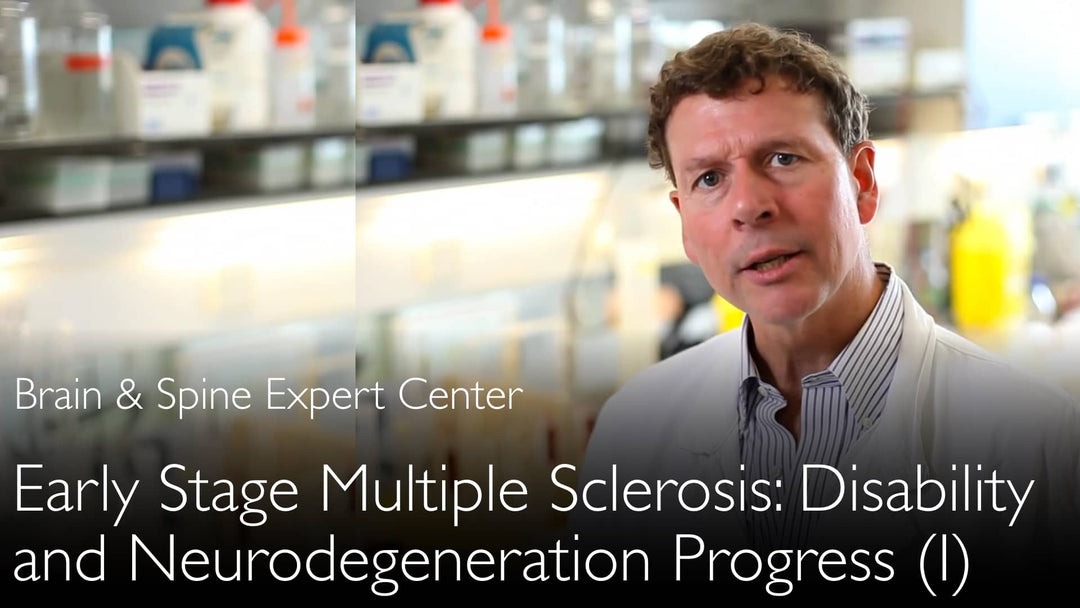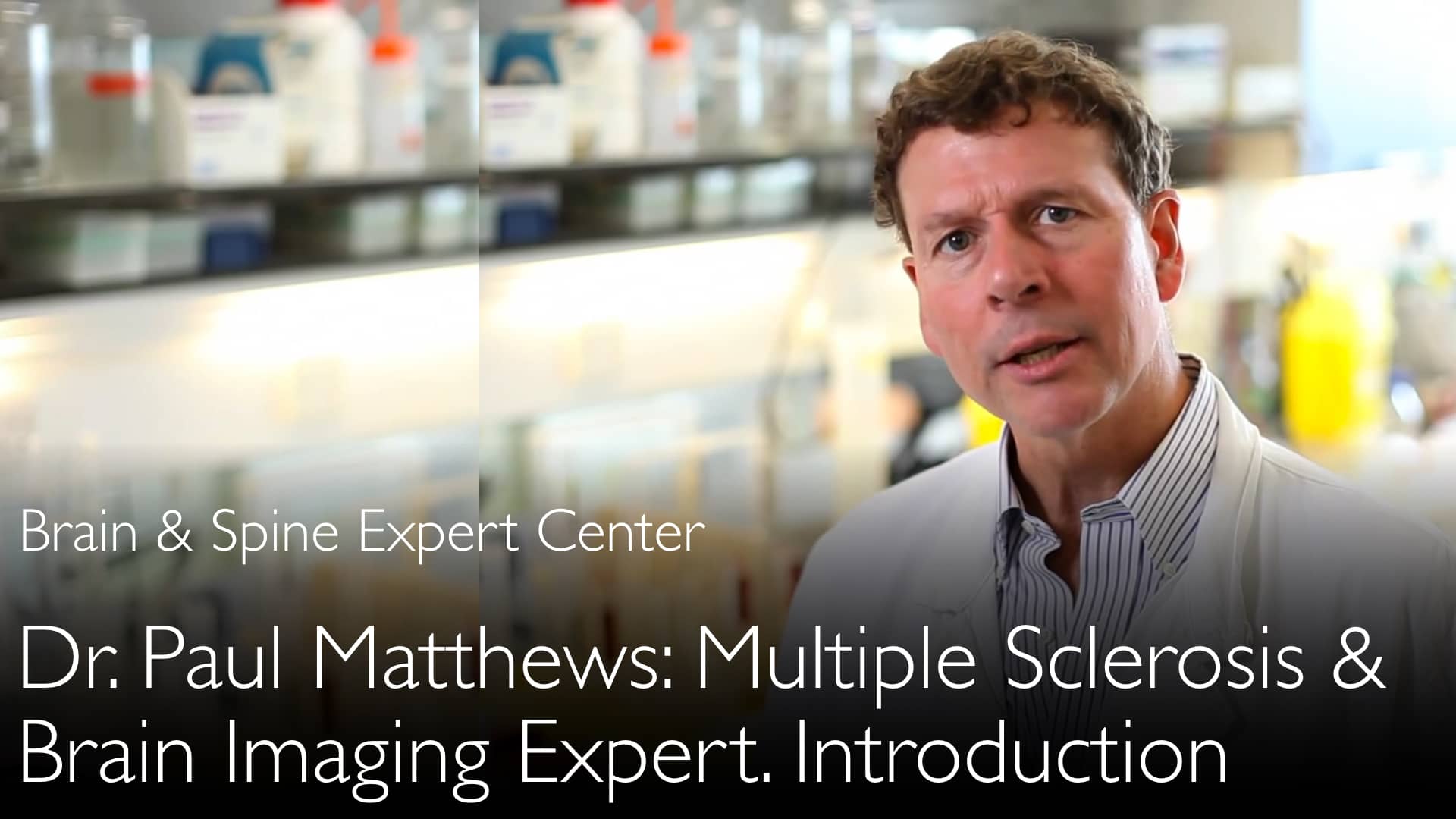מומחה מוביל בתחום הניוון העצבי וטרשת נפוצה, ד"ר פול מתיוס, MD, מסביר כיצד אובדן האקסונים מתחיל בשלב מוקדם בטרשת נפוצה ומוביל לנכות קבועה. הוא מפרט כיצד טכניקות MRI יכולות למדוד את אובדן נפח המוח כסמן ביולוגי מרכזי. ניוון עצבי זה מתקדם בקצב קבוע מתסמינים ראשונים. התערבות טיפולית מוקדמת חיונית למניעת נזק מצטבר והתקדמות הנכות.
אובדן אקסונים מוקדם וניוון עצבי בטרשת נפוצה
קפיצה לפרק
- אובדן אקסונים מוקדם ונכות
- MRI ומדידת נפח מוח
- קצב ניוון עצבי קבוע
- חיזוי התקדמות הנכות
- השלכות על טיפול מוקדם
- תמלול מלא
אובדן אקסונים מוקדם ונכות
ד"ר פול מתיוס, MD, קובע כי המטרה העיקרית של טיפול בטרשת נפוצה חייבת להיות הפחתת נכות קבועה. הוא מדגיש שנכות קבועה זו נובעת ישירות מאובדן אקסונים מצטבר. באופן קריטי, נזק אקסוני זה מתרחש מוקדם מאוד בתהליך המחלה. ד"ר פול מתיוס, MD, מסביר כי החלטות טיפול לא צריכות להתבסס אך ורק על חומרת התסמינים הקליניים של המטופל ברגע נתון. במקום זאת, הטיפול חייב להתמקד במניעת הפגיעות המצטברות המובילות לנזק נוירולוגי בלתי הפיך.
MRI ומדידת נפח מוח
שיטות MRI מתקדמות מספקות כלים חזקים להערכת ניוון עצבי בטרשת נפוצה. ד"ר פול מתיוס, MD, מציין כי בדיקות אבחון אלו יכולות לזהות אובדן נוירונים ואקסונים כבר בשלבים המוקדמים ביותר של המחלה. זה כולל את שלב התסמונת הבודדת הקלינית (CIS), אשר לרוב מהווה שלב מקדים לאבחון רשמי של טרשת נפוצה. סמן ביולוגי מרכזי הוא אובדן נפח מוח, המשמש כמדד עקיף לפגיעה בתאי עצב ובאקסונים שלהם. עבודה פורצת דרך של פרופ' ניקולה דה סטפנו הדגימה את התועלת בגישה זו למעקב אחר פעילות המחלה.
קצב ניוון עצבי קבוע
ממצא קריטי במחקר טרשת נפוצה הוא קצב הניוון העצבי העקבי. ד"ר פול מתיוס, MD, מדגיש שקצב אובדן נפח המוח מתקדם בערך באופן שווה לאורך כל מהלך מחלת הטרשת הנפוצה. זה意味着תאים עצביים ואקסונים continue to die מהתסמינים הראשונים של התסמונת הבודדת הקלינית ועד לשלב המתקדם המשני. מחקר landmark מד"ר אליזבת פישר וד"ר ריק רודיק ממרפאת קליבלנד תמך בכך. הם studied cohorts of MS patients for over a decade, showing that rates of brain volume loss remained approximately constant over that extended time.
חיזוי התקדמות הנכות
מדידת אובדן נפח המוח אינה רק כלי אבחוני; היא גם מדד פרוגנוסטי חזק. ד"ר פול מתיוס, MD, מסביר כי קצב אובדן נפח המוח לאורך זמן הוא מנבא טוב להתקדמות הנכות בטרשת נפוצה. מתאם זה מדגיש את הקשר הישיר בין הניוון העצבי הבסיסי להחמרה הקלינית שחווים המטופלים. ממצא זה אושר על ידי קבוצות מחקר מרובות, כולל עבודתם של ד"ר מתיוס ועמיתיו. הוא מספק מטרה כמותית לטיפולים aimed at slowing disease progression.
השלכות על טיפול מוקדם
גילויים אלה have profound implications for treatment strategy in multiple sclerosis. ד"ר פול מתיוס, MD, טוען כי תזמון ההתערבות הטיפולית must reflect the timing of axonal damage, which begins early. לכן, טיפול effective should be initiated as soon as possible to prevent cumulative damage. הריאיון עם ד"ר אנטון טיטוב, MD, explores how these insights should directly influence a neurologist's choice of treatment strategy. המטרה היא להגן על מערכת העצבים from the relentless assault that leads to permanent disability, making early and effective intervention paramount.
תמלול מלא
ד"ר אנטון טיטוב, MD: אתה אחד מכמה נוירולוגים מובילים שגילו וחקרו ניוון עצבי בטרשת נפוצה. עבדת עם ד"ר דאגלס ארנולד מאוניברסיטת מקגיל במונטריאול. עבדת עם ד"ר מרגרט אסירי, נוירופתולוגית מאוקספורד. חקרת אובדן אקסונים בטרשת נפוצה.
אצטט מאחד ממאמרי המחקר שלך על טרשת נפוצה: "המוקד העיקרי לטיפול בטרשת נפוצה חייב להיות הפחתת נכות קבועה. מקובל שנכות קבועה נובעת מאובדן אקסונים מצטבר. אובדן אקסונים זה מתרחש מוקדם מאוד בטרשת נפוצה."
טיפול effective may be available. Then the timing of therapeutic intervention should reflect the timing at the start of axonal damage. That would mean treating multiple sclerosis early. Treatment decisions should not be based on the severity of the clinical state of multiple sclerosis. Therapy must focus on preventing the cumulative assaults. Cumulative damage results, eventually, in permanent disability.
This has profound implications for treatment strategy in multiple sclerosis. Can you assess by MRI the neuronal and axonal loss in a patient with a recent diagnosis of multiple sclerosis? How would that affect the treatment strategy choices in multiple sclerosis patients?
ד"ר פול מתיוס, MD: I think we have learned that we can use a variety of diagnostic tests based on different imaging techniques. We can identify neuron and axon loss. We can do that even at the earliest stages of multiple sclerosis in the clinically isolated syndrome.
Seminal work was done by Professor Nicola De Stefano, now at the University of Siena. It showed that the rate of brain volume loss progresses approximately equally through the entire course of multiple sclerosis disease. Brain volume loss is an indirect measure of the injury to nerve cells and axons.
It means that nerve cells continue to die from the first symptoms of multiple sclerosis with the clinically isolated syndrome through to the late secondary progressive phase of multiple sclerosis. The rate of death of axons and nerve cells remains approximately similar.
Further data has come to demonstrate it even more directly. Dr. Elizabeth Fisher, during the time that she was at the Cleveland Clinic, discovered this important finding in multiple sclerosis. Together with Dr. Rick Rudick and their colleagues, she studied cohort patients from the initial treatment groups with interferon beta over an extended period of time.
They studied multiple sclerosis patients well over a decade. They demonstrated that the rates of brain volume loss over that time were approximately constant. Moreover, in other work, she and a variety of other workers, including ourselves, show that the rate of brain volume loss in multiple sclerosis over time is a good predictor of the progression of disability.





